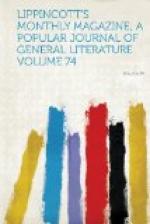[Illustration: KANGAROO HUNT.]
[Illustration: CATTLE-HUNTING.]
Ballarat, the centre of one of the chief mining districts, is connected now by railway with Melbourne, so that in the interval of only four hours one passes from the commercial metropolis to the “City of Gold.” Over the fertile belt of cultivated lands that surrounds Melbourne, through rugged rocks and barren sands, runs this road, on which one meets crowds of pedestrians, many of them barefoot, the sole capital of each a tent and a pickaxe. Nearing the mines, the aspect of everything is changed: whole forests of trees demolished as if by a thunderbolt; rivers turned out of their natural bed; fertile meadows laid waste; gaping chasms and frightful depths here and there, in which are men toiling half naked, begrimed with mud, and fierce, reckless, cadaverous faces that tell of hardships and strife and sin in the eager pursuit of riches. Ballarat was at first only a mining-camp of immense size, and its environs are still occupied by tents, where transient visitors find very passable accommodations. But the city proper, now some sixteen years old, with a population already of thirty thousand, is an exact transcript of Melbourne, with beautiful dwellings, and broad streets thronged with carriages by day and lighted with gas by night. It boasts already its clubs and theatres, its banks and libraries and reading—rooms, where the successful miner may invest his earnings, cultivate his intellect and seek recreation for his leisure hours.
[Illustration: COMPANIONS OF THE HUNT.] There are over two thousand mining districts in Australia, of which one of the richest is “Black Hill Mine,” but why called “Black Hill” it would be difficult to say, as its beautiful glistening sands are far nearer white than black. Next to gold, the most valuable ore is mercury, immense quantities of which are shipped annually to England from these mines. Iron-ore is found in nearly every part of the island, much of it so rich as to produce nearly three-fourths of its weight of metal. Topazes of rare beauty are frequently obtained, and coal is




